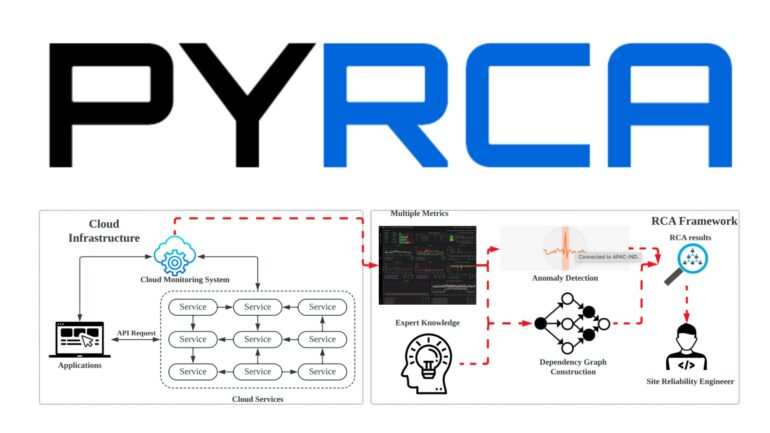TL;DR:
- PyRCA is an open-source Python Machine Learning library designed for Root Cause Analysis (RCA) in the field of Artificial Intelligence for IT Operations (AIOps).
- It provides a comprehensive framework for discovering causal relationships between metrics and incident root causes.
- The library offers graph building, scoring operations, and supports various widely used RCA models.
- PyRCA enables quick model creation, testing, and deployment, with a focus on user-friendly interface and streamlined user experience.
- It includes a GUI dashboard for interactive RCA, allowing users to visualize results and inject expert knowledge into the process.
Main AI News:
The world of artificial intelligence and machine learning is advancing at an astonishing pace, offering immense potential and transformative applications across diverse industries. As AI continues to make significant strides and becomes integrated into various domains, it is not without its challenges and limitations. Root cause analysis (RCA) emerges as a crucial method for unraveling the underlying causes of issues, enabling the discovery of optimal solutions. By identifying the fundamental reasons behind incidents or failures in models, RCA plays a pivotal role in domains such as IT operations, telecommunications, and the field of AI itself. The growing complexity of models often gives rise to events that undermine the dependability and effectiveness of production systems. Through the power of RCA, multiple factors are scrutinized, and causal relationships are established, offering valuable insights into these instances.
In a remarkable development, a team of talented researchers from Salesforce AI has unveiled PyRCA—a remarkable open-source Python Machine Learning library meticulously crafted for Root Cause Analysis (RCA) within the realm of Artificial Intelligence for IT Operations (AIOps). PyRCA provides an all-encompassing framework that empowers users to autonomously explore intricate causal relationships between metrics and the root causes of incidents. With a unified interface supporting a range of widely adopted RCA models, PyRCA facilitates both graph construction and scoring operations, while also streamlining model creation, testing, and deployment processes.
This comprehensive Python library for root cause analysis comprises an end-to-end framework, encompassing data loading, causal graph discovery, root cause localization, and RCA result visualization. By accommodating multiple models for graph creation and root cause evaluation, PyRCA aids users in swiftly loading relevant data and discerning the causal connections between various system components. To enhance the user experience and align with real-world conditions, PyRCA incorporates a GUI dashboard that facilitates interactive RCA, providing a seamlessly integrated workflow. The intuitiveness of the point-and-click interface empowers users to effortlessly interact with the library and infuse their expert knowledge into the RCA process.
Engineers and researchers can now leverage PyRCA to delve into the analysis of results, visualize causal linkages, and seamlessly navigate through the RCA process using the GUI dashboard. Let’s explore some of the noteworthy features of PyRCA as shared by the team:
- Standardized Framework: PyRCA is designed to provide a standardized and highly adaptable framework, enabling users to load metric data effortlessly using the popular pandas.DataFrame format. Additionally, it offers benchmarking capabilities with a diverse set of RCA models.
- Versatile Model Selection: Through a single interface, PyRCA grants access to a variety of models for discovering causal networks and uncovering underlying causes. Users also have the flexibility to customize each model according to their unique requirements. The available models include GES, PC, random walk, and hypothesis testing.
- Domain Knowledge Integration: The RCA models provided by PyRCA can be further strengthened by incorporating user-provided domain knowledge. This integration enhances the models’ resilience when dealing with noisy metric data, enabling more accurate and robust analysis.
- Extensibility: By implementing a single class inherited from the RCA base class, developers can seamlessly introduce new RCA models to PyRCA. This extensibility feature empowers the community to contribute and expand the library’s capabilities.
- Visualization and Collaboration: PyRCA offers a powerful visualization tool that enables users to compare multiple models, review RCA results, and effortlessly incorporate domain knowledge—all without the need for any code. This promotes collaboration and expedites the RCA process.
For a detailed understanding of PyRCA’s architecture and its core functionalities, the team has provided a comprehensive technical report. The report offers insights into the library’s design and its ability to revolutionize RCA practices.
Conclusion:
The introduction of PyRCA into the market signifies a significant advancement in the field of AIOps and root cause analysis. With its robust capabilities and versatile framework, PyRCA empowers businesses and professionals to gain deeper insights into the underlying causes of incidents and failures. By offering a user-friendly interface, streamlined workflows, and the ability to incorporate domain knowledge, PyRCA enhances the efficiency and accuracy of the RCA process. This, in turn, enables organizations to address issues promptly, optimize system performance, and deliver higher levels of dependability to meet the evolving demands of the market. The availability of PyRCA as an open-source library further fosters collaboration and innovation within the AIOps community, driving continuous advancements and propelling the market forward.

